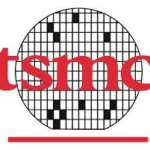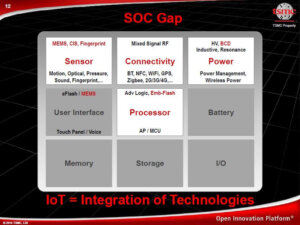“Go big or go home,” a waitress in a mountainy, remote, Wyoming town once said to a table of hikers, about ordering breakfast one summery day.
Go big or go home are words Karen Lightman and team at MEMS Industry Group must have taken to heart for the 10th Annual MEMS Executive Congress, held at the JW Marriott Camelback Inn, Scottsdale, AZ, November 6-7, 2014.
Taiwan Semiconductor Manufacturing Company, Ltd. is, by far, the world’s largest pure-play semiconductor foundry, with sales revenue of $19.85B in CY2013, according to IC Insights; “In fact, TSMC’s 2013 sales were over 4x that of second-ranked GlobalFoundries and 10x the sales of the fifth-ranked foundry SMIC.”
MIG went big at MEC 2014 by having George Liu, director, sensor and driver business development, TSMC, as the morning keynote speaker opening the congress, and Mr. Liu went big with his talk on “The Next Big Thing.”
Nobody went home.
Just what will be the next big thing, Mr. Liu? According to TSMC, the next big thing will have 10x growth over previous next big things, which were personal computing and internet, represented by the PC; mobile communication, represented by the mobile phone; and smart mobile computing, represented by the smartphone.
The next big thing will not be one big thing, or one big platform.
The next big thing, thinks TSMC, will be smart things packed with MEMS sensors; smart things embedded in our smart, smart wearables, which we will don in our chic smart homes, before we go out to our sporty smart cars to travel, for work or for pleasure, to our sophisticatedly smart cities.
 The TSMC-envisioned future, just like Scottsdale mornings in early November, will be so bright you’ll have to wear (smart) shades.
The TSMC-envisioned future, just like Scottsdale mornings in early November, will be so bright you’ll have to wear (smart) shades.
(Although I hear much this month about Google Glass trending down. Surely there’ll be other smart shades, if not Google Glass shaded, then, as part of the next big thing.)
TSMC made its name by offering foundry services for logic chips to such customers as Qualcomm, AMD, NVIDIA, Xilinx, and Apple.
Logic functions, in the form of embedded processor cores, etc., are the smart part of smart things, and TSMC already does smart very, very well.
But what about the sensors part?
It’s there, in sensors, that TSMC plans to clean up by backing in, with an initiative that uses its own version of the IoT acronym, which TSMC has co-opted to mean Integration of Technologies.
If TSMC can back in to the presently open gaps in the System on Chip (SoC) space by offering additional functionality, e.g. analog functions, MEMS sensors, energy harvesting, power management, and wireless connective for new SoC designs, TSMC will pretty much clean up in the smart things future of microelectronic device manufacturing even more than they clean up now (4x revenues over the closest competitor!).
TSMC’s Integration of Technologies is heterogeneous integration traveling under a different name, a name that takes advantage of the already crazy amount of #IoT, Internet of Things, traffic trending on Twitter, in the blogosphere, in the news, on the Gartner Hype Cycle curve, and maybe even on your lips.
(TSMC also posits there are gaps in the packaging world that need filling for the smart things future, most notably gaps in commercially viable interposers, and commercially viable 3D IC processes using TSVs.)
SoC is going to become SSoC – System and Sensor on Chip.
George Liu offered some pretty compelling arguments in his talk as to why TSMC thinks it’s going to clean up in SSoC; one of those compelling arguments goes like this: that by being all technologies to all people TSMC will eliminate the natural design barriers that exist when product design engineers attempt to integrate logic, MEMS sensors, and analog components produced by three different suppliers into a single packaged system.
Anything goes wrong in the standard model and the fingers point everywhere; anything goes wrong in TSMC’s integrated model and the fingers all point to TSMC.
Fair enough, but the really compelling arguments George made for TSMC’s thrust into smart sensors / SSoC / IoT / heterogeneous integration all circle back to economics and efficiency.
TSMC’s value proposition for heterogeneous integration at TSMC is all about ecosystem efficiency, R&D efficiency, and capital investment efficiency.
By eliminating the supply chain gaps in heterogeneous integration the (TSMC) foundry model wins.
In the brave new world of the next big things, smart things, having no baggage is the advantage.
Lose your baggage, and collaborate to win.
 Or abandon all hope ye who enter here hoping to compete?
Or abandon all hope ye who enter here hoping to compete?
From Pittsburgh, PA, thanks for reading.
PFW





![[err-ad-fallback-title]](http://www.3dincites.com/wp-content/plugins/a3-lazy-load/assets/images/lazy_placeholder.gif)















